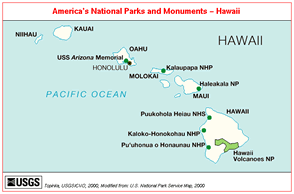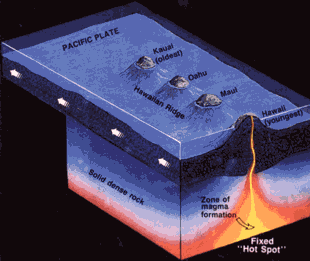World volcano Profiles >North America > Hawaiian Volcanoes
Hawaiian volcanoes
New Kilauea Summit Webcam from the USGS Hawaiis volcanoes are one of the geological wonders of the world.The volcanoes Kilauea,Mauna Loa and Mauna Kea are some of the most famous volcanoes in the world. Current volcanic activity in Hawaii is on Big Island mostly within the Hawaii volcanoes National Park from Kilauea and Pu oo oo its side vent.Mauna Loa and Mauna Kea are more dormant.All the volcanoes are monitored by the Hawaii volcano observatory.
Hawaiis volcanoes are one of the geological wonders of the world.The volcanoes Kilauea,Mauna Loa and Mauna Kea are some of the most famous volcanoes in the world. Current volcanic activity in Hawaii is on Big Island mostly within the Hawaii volcanoes National Park from Kilauea and Pu oo oo its side vent.Mauna Loa and Mauna Kea are more dormant.All the volcanoes are monitored by the Hawaii volcano observatory.
There are 8 main Islands which form the worlds most isolated archipeligo 2500 miles of the West coast of North America. All the Islands are volcanic in origin and Kilauea one of the most accessible;its name means "much spewing". Most of the earths land volcanoes are due to movements where the earths tectonic plates meet, Hawaii is away from all plate boundaries and is an example of Intra-plate volcanism.
 Hollywood loves rivers of glowing high speed lava and they would have you believe that all volcanoes erupt like the ones in Hawaii. Pele is the goddess of the volcano in Hawaii and can be fiery girl so beware.
Hollywood loves rivers of glowing high speed lava and they would have you believe that all volcanoes erupt like the ones in Hawaii. Pele is the goddess of the volcano in Hawaii and can be fiery girl so beware.
Hawaii Volcanoes National Park is located 100 miles SE of Kona and 30 miles south of Hilo. From the east you drive through rainfroest from the west across lava fields and the flanks of Mauna Loa. The weather is fresher than by the coast. You can take a helicopter ride over the volcanoes or sign up for a volcano tour.
The Geology Bit
Hawaiin volcanic activity is due to a Mid-ocean Hot Spot or mantle plume firing a jet of hot rock at the base of the Pacific Ocean crust over the past 70million years to form the Hawaiin-Emperor Semount chain . The jet of hot rock punches a hole through the crust and creates a volcano which eventually emerges from the ocean as an island. As the Pacific plate has moved to the NW over the Hot Spot at a rate of 5-10cm /year , islands have moved away from the Hot Spot and new volcanic islands have been created. The older volcanic isalnds erode until they become coral atolls and eventually dissapear beneath the waves to become sea mounts. The entire chain is 5000km long the oldest sea mount being near the Aleutian trench near Alaska and the youngest volcano is Lo'ihi , which is still submerged off the coast of Big Island( Hawaii Island). 
The main rock type is basalt and it typically erupts in lava fountains, fissure eruptions and effusive lava flows.Two types of lava flow are named from Hawaiin ;" Aa-aa" is a blocky, rocky slow moving lava flow , supposedly called aa-aa because it is very sharp and rough and hurts your feet! "Pahohoe" is smoother and faster moving and resembles coils of rope and loops and flows a bit like syrup. The volcanoes on the isalnds are located in two rows which wextend across the islands. The islands are put such pressure on the crust that thwy have depressed it. The mantle plume keeps them from sinking further until they move off the bouyant spot and then they subside futher.
Rivers of pahohoe lava glowing red,orange and yellow are a frequent images of volcanoes and Hawaii is where many of the pictures come from. Hawaiin volcanoes rarely claim lives but they can change the landscape dramatically as their lava flows blanket forests,homes,roads,valleys and farmland.


